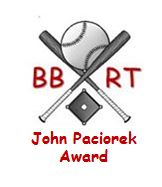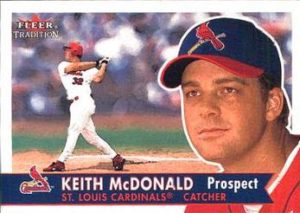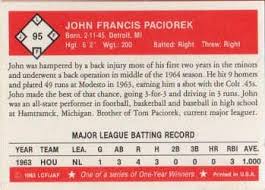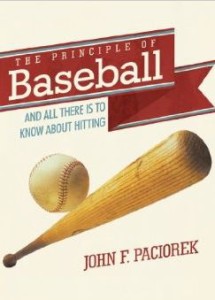 In 2014, Baseball Roundtable launched the John Paciorek Award (JPA). The JPA recognizes players who have had short, often very short, major league careers, but whose accomplishments, nonetheless, deserve recognition. (Note: Information on John Paciorek’s career – the inspiration for the JPA – can be found at the end of this post. Paciorek’s day in the sun constitutes arguably the best one-game MLB career ever.)
In 2014, Baseball Roundtable launched the John Paciorek Award (JPA). The JPA recognizes players who have had short, often very short, major league careers, but whose accomplishments, nonetheless, deserve recognition. (Note: Information on John Paciorek’s career – the inspiration for the JPA – can be found at the end of this post. Paciorek’s day in the sun constitutes arguably the best one-game MLB career ever.)
________________ 2018 JPA Winner – Keith McDonald _______________
The fans are going to expect it every time, but it may be a long time before I hit another one.
St. Louis Cardinals catcher Keith McDonald
July 6, 2000
 Keith McDonald speculated on the timing of his next MLB home run shortly after the Cardinals/Reds contest during which he had become just the second player in history to homer in his first two major league at bats. As it worked out, neither he nor the Redbirds’ fans, had to wait that long. His next MLB long ball came just nine days (July 15) and three plate appearances later – giving him three home runs in his first six MLB at bats (eight plateappearances, he also drew a pair of walks).
Keith McDonald speculated on the timing of his next MLB home run shortly after the Cardinals/Reds contest during which he had become just the second player in history to homer in his first two major league at bats. As it worked out, neither he nor the Redbirds’ fans, had to wait that long. His next MLB long ball came just nine days (July 15) and three plate appearances later – giving him three home runs in his first six MLB at bats (eight plateappearances, he also drew a pair of walks).
Just as McDonald had no idea of how short the span of time between career home runs number-two and number-three would be, he probably was equally in the dark as to how few at bats would fall between home run number-three and his final major league plate appearance – or that his MLB career stat line would include just eight games, 11 plate appearances (two walks), three hits in nine at bats (.333 average), three home runs, three runs scored and five RBI. (That, for those more deeply into stats, is an MLB career on base percentage of .455 and a slugging percentage of 1.333.
Keith McDonald is the only MLB player with more than one career hit, who can look back on major league tenure when his every hit was a home run.
I’m getting a little ahead of myself. Let’s look back on how Keith McDonald found his way into the MLB record book.
McDonald was a star athlete for Esperanza High School (Anaheim, California). He was a three-year starter at quarterback – throwing for 31 touchdowns in his junior and senior seasons. He also was a three-year player on the school baseball squad: a catcher as a sophomore; third baseman and relief pitcher as a junior; and first baseman and pitcher as a senior. How good was he? In his senior season, McDonald hit .406 and put up a 1.90 ERA (4-0, with three saves).
Selected in the 18th round of the 1993 MLB Draft, McDonald chose instead to accept a scholarship to the University of Utah; where he would be able to play both football and baseball. Things didn’t work out at Utah, however, and – after a difficult period of adjustment, a “red shirt” season in football and a challenging year on the diamond – McDonald chose to return to California. He transferred to Cypress College (Cypress, CA), where he combined his studies with a .353-8-37 line in 55 games (and threw out 34 of 62 base runners attempting to steal). In 1994, it was on to Pepperdine University (Malibu, CA), where he hit .266, with seven home runs and 24 RBI in 48 games.
The St. Louis Cardinals selected the 6’2”, 215-pound, 21-year-old in the 24th round of the 1994 draft – and McDonald’s pro career was underway. From 1994 to 1999, McDonald worked his way up through Rookie ball, A, High A, Double A and Triple A (Memphis Redbirds). His best seasons were 1998 (.318-7-22 in 58 games at Triple A) and 1999 (.304-7-41 in 88 games at Double A and Triple A combined).
As he started the 2000 season at Memphis, McDonald had little idea he was on the brink of MLB history. He was hitting .246, with one home run and 17 RBI for the Memphis squad as the season moved into July – and, more important, precisely when Cardinals’ backup catcher Eli Marrero injured his hand attempting to steal a base. On July 2, McDonald was called up to the big club to replace Marrero – a move McDonald has said even surprised him.
He got his first taste of MLB action on July 4, before an Independence Day crowd of 46,022 (in St, Louis). McDonald came to the plate as a pinch hitter (for SS Edgar Renteria) in the bottom of the eighth inning – with the Cardinals ahead by a 13-3 score. It was a good opportunity to provide a rookie with a low-pressure first MLB at bat. After hitting just one home run in 177 at bats at Triple A that season, McDonald sent a 2-2 pitch out of the park to left-center. The blast made him the 79th players to homer in their first MLB at bat.
McDonald did not play in the Reds/Cardinals July 5, tilt, but On July 6 – this time before a crowd of 43,287 – McDonald started at catcher against the Reds, batting in the number-eight spot. He got his first at bat in the bottom of the second, with the Cardinals trailing 3-2. He tied the game with a home run on a 1-0 pitch – becoming just the second MLB player ever to homer in their FIRST TWO plate appearances. He finished the day one-for-three with a walk and two RBI.
Keith McDonald is one of only two players – and the only National Leaguer – to homer in his first two major league plate appearances.
In McDonald’s next MLB game (July 8) – with the Cardinals hosting the Giants – McDonald replaced Matheny at catcher in the top of the ninth, with the Giants up 7-6. McDonald came to the plate in the bottom of the inning and drew a walk. He didn’t take the field again until July 13, when he again entered the game as a pinch hitter (this time in the top of the ninth with the Cardinals up 13-3 on the White Sox in Chicago). He grounded out to second.
Two days later (July 15), still in Chicago, McDonald pinch hit again. This time, it came in the top of the ninth of a game in which the Cardinals trailed 15-5. McDonald popped a 3-1 pitch for a two-run home run. (Attendance 40,681.) At this stage of his MLB career, he was three-for-six – with all three his hits leaving the yard and all before crowds in excess of 40,000. Talk about coming through on the big stage. McDonald got only one more major league at bat that season, a ninth-inning, pinch-hit fly out against the Twins on July 15.
Keith McDonald’s three MLB hits, all home runs, were witnessed by crowds (announced attendance) totaling 129,990.
Then, as suddenly as it began, it was over. On July 21, McDonald was sent back down to Memphis, where he finished the season .263-5-30 in 83 games. He appeared in just two more major league games – in September of 2001 – going hitless in two at bats. McDonald then spent the next five seasons at AAA; playing in the Cardinals’, Cubs’, Pirates’, Rangers’ and Yankees’ systems. He played a total of 13 minor league seasons, hitting .264, with 78 home runs and 418 RBI.
It was, however, that remarkable – short, but sweet – run in in 2000 that caught BBRT’s eye and earned Mcdonald John Paciorek Award recognition. Keith McDonalds’s major league career may have been short, but those three home runs must have been sweet.
________________________________________________________
PAST JOHN PACIOREK AWARD WINNERS:
2014 – Brian Scott Dallimore
In his first start (not his first game) for the 2004 Giants, Dallimore had two singles, a Grand Slam (his first MLB hit and only MLB home run), a walk and a hit by pitch. For the full JPA take on Dallimore’s 27- game MLB career, click here.
2015 – Roy Gleason
Gleason played in just eight MLB games, had a double in his only MLB at bat – but also earned a World Series ring (1963) and a Purple Heart. Ultimately, he was the only ballplayer with MLB experience to serve on the front lines in Vietnam. For the full JPA take on Gleason, click here. Note: Gleason’s life is detailed in the book “Lost in the Sun – Roy Gleason’s Odyssey from the Outfield to the Battlefield.”
2016 – John Allen Miller
Miller played just 32 MLB games (during the 1966 and 1969), taking the field (at 1B/LF/3B/2B) for the Yankees and Dodgers. Miller collected ten hits in 61 MLB at bats (.164 average) and hit just two home runs – but he made those long balls count. Miller made his MLB debut with the Yankees on September 11, 1966 and hit a two-run homer in his first big league at bat – making him (surprisingly) the first Yankee ever to homer in his first MLB at bat. (Little did Miller know he would not get another home run or RBI until the final at bat of his MLB career.) Miller’s final at bat came as a Dodger (September 23, 1969) and he stroked a solo home run. That narrow “body of work” made Miller one of just two players in MLB history to homer in their first and final official appearances in a major league batter’s box. For more on Miller, click here.
2017 – Chris Saenz
RHP Chris Saenz’ big day came on April 24, 2004 – when he was called up from Double A Huntsville (where he was 1-1, 3.86) to make a spot start against the Saint Louis Cardinals, whose powerful lineup included the likes of Albert Pujols, Scott Rolen, Jim Edmonds and Reggie Sanders. The rookie went six innings, giving up just two hits, three walks and no runs, while fanning seven. There was some speculation (primarily among sportswriters and fans) that Saenz’ performance might earn him another start or two, but two days after his debut, he was on his way back to Huntsville. Unfortunately, his minor league season included a September elbow injury that required Tommy John surgery and he never returned to the majors. Statistics before 1900 can be sketchy, but baseball-reference.com shows that Saenz is the only pitcher to complete a one-game MLB career of at least five innings pitched, without giving up a single run (earned or unearned). For more details on this JPA honoree, click here.
—–INSPIRATION FOR THE JPA—-–
John Paciorek – signed out of Saint Ladislaus High School in Hamtramck, Michigan (where he had starred in football, basketball and baseball) – appeared in his first major league game on the final day of the 1963 season (September 29) at the age of 18. The 6’ 1”, 200-pound outfielder had spent the 1963 season with Class A Modesto Colts. The Colts’ parent club, the Houston Colt .45s (that was the current Astros’ franchise name back then), was suffering through a difficult season. The team was 65-96 going into that final game. Looking to the future, Houston had, in fact, fielded an all-rookie lineup (average age 19) on September 27. Youth was still being served two days later when John Paciorek started his first MLB game. The results were surprising – and worthy of recognition.
 Playing right field and batting seventh in a 13-4 win over the NY Mets, Paciorek ended up with three hits and two walks in five plate appearances, with four runs scored and three runs batted in. Perhaps equally surprising is that it was not only Paciorek’s first major league appearance, it was to be his only MLB appearance. Back pain the following spring, followed by surgery (he played 49 minor league games in 1964 and missed all of the 1965 season), put an end to his MLB playing days. (Paciorek did play in four more minor league seasons.) Still, you will find John Paciorek in the Baseball Encyclopedia and his is arguably the greatest one-game MLB career ever. Among one-gamers, he holds the record for times on base and runs scored, and shares the record for batting average, on base percentage and RBIs.
Playing right field and batting seventh in a 13-4 win over the NY Mets, Paciorek ended up with three hits and two walks in five plate appearances, with four runs scored and three runs batted in. Perhaps equally surprising is that it was not only Paciorek’s first major league appearance, it was to be his only MLB appearance. Back pain the following spring, followed by surgery (he played 49 minor league games in 1964 and missed all of the 1965 season), put an end to his MLB playing days. (Paciorek did play in four more minor league seasons.) Still, you will find John Paciorek in the Baseball Encyclopedia and his is arguably the greatest one-game MLB career ever. Among one-gamers, he holds the record for times on base and runs scored, and shares the record for batting average, on base percentage and RBIs.
 Paciorek, by the way, went on to become a high school teacher and multi-sport coach and is the author of two books (Plato and Socrates – Baseball’s Wisest Fans and The Principles of Baseball: And All There Is To Know About Hitting.) You also can enjoy Paciorek’s prose (and expertise) directly at his blog “Paciorek’s Principles of Perfect Practice” by clicking here. You can find out even more about Paciorek in Steven Wagner’s 2015 book “Perfect: The Rise and Fall of John Paciorek, Baseball’s Greatest One-Game Wonder.” (See the review of “Perfect” by clicking here.)
Paciorek, by the way, went on to become a high school teacher and multi-sport coach and is the author of two books (Plato and Socrates – Baseball’s Wisest Fans and The Principles of Baseball: And All There Is To Know About Hitting.) You also can enjoy Paciorek’s prose (and expertise) directly at his blog “Paciorek’s Principles of Perfect Practice” by clicking here. You can find out even more about Paciorek in Steven Wagner’s 2015 book “Perfect: The Rise and Fall of John Paciorek, Baseball’s Greatest One-Game Wonder.” (See the review of “Perfect” by clicking here.)
A final note. John Paciorek’s insight into the national pastime should come as no surprise. Paciorek comes from a true “baseball family.” He was the first born of eight siblings and was followed to the big leagues by younger brothers Jim and Tom Paciorek. (Like John, Jim’s MLB career was short – 48 games for the Brewers in 1987. Brother Tom, however, achieved a .282 average over an 18-season MLB career.)
Primary Resources: Baseball-Reference.com; MCPower Surge, Los Angeles Times, July 9, 2000, Lon Eubanks; McDonald’s College Tour Stops Again, Los Angeles Times, July 8, 1993, Martin Henderson.
I tweet (on X) baseball @DavidBaseballRT
Follow/Like the Baseball Roundtable Facebook page here.
Member: Society for American Baseball Research; The Baseball Reliquary; The Negro Leagues Baseball Museum.






Billy Rohr,Red Sox 1967 deserves an award-no hitter into the ninth in first start,shoutout his 2nd,then nothing much !